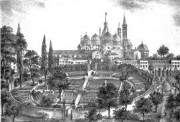The Origins
Michelangelo Buonarroti was born in Caprese, in Arezzo’s province , in 1475 AD. His father Ludovico di Leonardo Buonarroti was the Mayor of the village; he came from a prominent Florentine family, in which the members had always been employed in the public sector and Government. He lost his mother, Francesca di Neri del Miniato del Sera, at the age of five. Michelangelo was the second of five brothers. After a brief stay in Caprese, the family returned to Florence, and went to live in the village of Settignano, where there were many quarries of sandstone and almost everyone worked as stonecutter. Michelangelo’s nanny was a stonemason’s wife and, in later years, the great artist used to say that his childhood among all those stone powders, had destined him to sculpture. In his father’s plans, he had to become either a soldier or a prelate, but Michelangelo loved art too much to give it up and, after long struggles with his family, he managed to impose his wishes over his father ones. And so, in 1487 AD, Ludovico took the boy to the famous workshop of Domenico Ghirandaio, who, after seeing some sketchs of the child, decided to hire him as an apprentice, giving him a small salary, which his father used to balance the family budget. Michelangelo did not finish the three-year apprenticeship and continued his learning at the famous San Marco’s Garden, funded by Lorenzo the Magnificent, where he began to devote himself to sculpture. Lorenzo, impressed by the huge talent of the boy asked his father to have his permission to accommodate the guy at his Palace, just to enjoy his work. His father, given the influence and benefits of such a friendship, gladly accepted and Michelangelo moved to the Medicean Court.
Starting to carve
At the Medici’s Mansion, Michelangelo sculpted the “Madonna of the ladder ” (bas-relief) and the “Battle of the Centaurs” (relief), where he showed everyone his firm touch and delicate at the same time. Lorenzo’s successor, Piero de Medici, wasn’t as friendly with Michelangelo as it was Lorenzo, and led him to move to another place, identified in the Franciscan Convent of the Augustinian Friars, where the great artist was even allowed to dissect some dead persons and, significantly improve his knowledge of human anatomy. To thank the Friars for their hospitality, he sculpted and donated to them the “Wooden Crucifix” and “Hercules” ( now lost ).
In Bologna
In those years, Florence was living tormented moments, the Medici were no longer loved by the people and the monk Savonarola, great moralizer, overthrew their rule with the people’s help, expelling Piero de Medici from the City. Michelangelo, as a precaution, given its friendliness with the Medici family, he decided to move temporarily to Bologna, housed by Francesco Aldrovandi, a person close to the Lords of the City: the Bentivoglio family. He remained in Bologna about a year and there, he completed the great sculpture called “San Domenico’s Air“
Back to Florence
In 1495 AD he returned to Florence, where a Republican Government had settled. Some members of the exiled Medici family had returned, proclaiming themselves as commoners and friends of the people. Pierfrancesco de Medici housed and protected him, and, for his host, Michelangelo sculpted the “St. John” and the “Sleeping Cupid“, now lost. Later,, he came into contact with the murky, art market, sculpted a statue and, through an art merchant, sold it to a Roman Cardinal, passing it off as a very antique one, but the Prelate soon discovered the fraud, demanded the money back and craved knowing the author of such a wonder.
In Rome, working for the Church
In 1496 AD, summoned in Rome by the Cardinal, he went living in the house of the Papal emissary, Jacopo Galli, and carved, for the Cardinal, a beautiful “Bacchus”. When the Ecclesiastic Circles saw the beautiful statue, they began to order him numerous works. It was in those years that he carved one of his absolute masterpieces: ” The Pity “. This terrific statue of Jesus, held in the loving arms of his Mother Mary, emanated such an expressive and emotional power, unprecedented, that everybody who saw it, gasped. It was the first statue carved in Carrara’s marble, which from then on, became the favorite material of the artist.
Still back to Florence, as a Star
He returned to Florence as a real Star; everyone knew and appreciate him. Subverting the previous traditions, Michelangelo began sculpting on his own, becoming kind of an “entrepreneur”, and selling his works to the clients. In 1501 AD, he carved only 4 of 12 statues, commissioned by Cardinal Piccolomini for the Cathedral of Siena, preferring to go back to Florence, where everyone wanted to commission him to create important artworks. At that time, the Cathedral’s Opera commissioned him to carve a large statue, to be placed in a public square, that would symbolized the modern hero, the citizen-soldier: Michelangelo chose a huge block of Carrara’s marble, already outlined by some other sculptors, and after three years of work, he gave another of his absolute masterpieces to Florence: the David. The statue embodied the grace and power of the hero in the total style of Michelangelo, in which the sculpture were more dynamic and muscular than into the previous canons of those times. A committee, made up of artists, among who there also was Leonardo, decided to exhibit the wonder into the most beautiful and important Square of Florence: Signoria’s Square. Subsequently, the artist produced a series of round artworks, with Sacred Images ( Pitti’s Circle, carved in marble; Doni’s Circle, exquisitely painted , and Taddei’s Circle, also carved) and a bronze David ( now lost ). Many orders were coming, in those times, to Michelangelo’s attention, although some of them, as the 12 statues for the Cathedral, or the Bridge in Istanbul, were not even started and some others, such as the large fresco in Palazzo Vecchio, representing the Battle of Cascina (Florence victorious over Pisa), were only begun and never completed.
In Rome again, for the Sistine Chapel’s ceiling
In 1505 AD Pope Julius II° summoned him to Rome to sculpt his tomb, Michelangelo prepared a great project, selected the marble and when he was about to start it, was stopped by the Pope, distracted, in those times, by other events. Michelangelo then, thinking he had probably become unpopular with the Pope fled from Rome. The Pope, very sorry about it, managed to met him in Bologna, after defeating the local Lords (the Bentivoglio). Julius II° apologized for the grave’s standstill and gave him another extraordinary task: painting the great fresco on the Sistine Chapel’s’ ceiling. Michelangelo immediatly started to work; imagining the times before the Advent of the Apostles, and the theme of Original Sin and redemption of man at the hands of Jesus. He depicted the seven Prophets and the five Sibyls, sitting on their thrones at the sides of the ceiling and then, in the 9 spaces expressly created, painted the chronological scenes of Genesis: the separation of light from darkness, the creation of greenery, plants and stars, the separation of land from the seas, the creation of Adam, the creation of Eve, the original sin and the expulsion from Paradise, the sacrifice of Noah, and the Noah’s Drunkenness. Above these scenes, were placed some naked people with garlands and bronze medals, and scenes from the Old Testament, depicting the 40 generations of the ancestors of Jesus, were painted in the lunettes, and finally, in the four corners, inside the pendentives, other scenes from the Bible (Miracles for the elected people)were represented . The beautiful Chapel was inaugurated in 1512 AD. In 1513 AD Michelangelo resumed his work at the tomb of Julius II, ordered by his heirs, and meanwhile, carved other works: ” The first Christ of Minerva “, ” the two Prisons ” and ” Moses ” In the meantime, a member of the Medici family, Leone X°, had gone up to the Papal throne, and this fact brought Florence back, under the Medicean control, with the contemporaneous defeat of the Republican Government.
The Medicean Library and the New Sacristy in Florence
Leone X° commissioned to Michelangelo the project for the renovation of the San Lorenzo Church, the Church of the Medici family, but because of the prohibitive costs, it was never realized. In San Lorenzo, Michelangelo also created the beautiful New Sacristy, a Chapel with a square base, built to house the tombs of Lorenzo the Magnificent, his brother Giuliano and two cousins Lorenzo and Giuliano (homonyms). Above the tombs of two most renowned Medicis there are two pairs of human statues representing two allegories of the time, on the tomb of the Magnificent there are twilight and dawn and on the tomb of Giuliano there are day and night. In 1527 AD, Florence rebelled against the Pope, expelling his deputy Alexander de Medici, and restoring the Republic; Michelangelo, who had always been a little hostile to the Medici, despite their continued support, immediately converted himself to Republican ideals, working on several works commisioned by the new Government. But the life of the Republic wasn’t destined to be long, in fact the Emperor, the Pope and the Medicis swiftly regained the City, imposing a new, severe and stern Governor: Baccio Valori. Michelangelo, scared for his support to the Republic, fled then to Venice. The Pope, however, forgave him, on the condition that he returned in Florence, to his suspended work at the New Sacristy, and planned a new, great Medicean Library to be linked to the San Lorenzo Church. The impressive Library was designed and then built, and the work for the tomb of Julius II° resumed. Meanwhile the great artist received many other orders, most of which he could not fulfill.
In Rome for the last time
In 1534 AD, Pope Clement VII summoned Michelangelo in Rome, officially nominating him as the first painter, sculptor and architect of the Vatican. Michelangelo left then Florence and never came back. In Rome, he received the prestigious commission to paint the back wall of the Sistine Chapel with the theme of the Last Judgment, and this painting became another of his undisputed masterpieces. In the ” Judgement “, Jesus stands alongside the Blessed Virgin, and, from his throne, chooses the souls to be saved, which, in a kind of procession, all whirl around Him, surrounded by Saints and Prophets. It is a chaotic context, where the great movement is the most striking factor, quite far from the tradition of the time. The newly elected Pope, Paul III, commissioned Michelangelo to make a project for the restructuring of the Campidoglio Square, an important place in the City political life, since the Middle Ages. The project, fulfilled many years after Michelangelo’s death, was composed of a trapezoidal space converging to a main Building (Palace of the Senators), flanked, on the other two sides, by two Palaces (New Palace and Palace of the Conservatives); in the Square’s center it was expected a curvilinear grid, placed inside an ellipse, at whose center there would have been a statue of the Emperor Marcus Aurelius, as a link between the Empire and the Papal Authority. Nel1542 AD Pope Paul III commissioned two frescoes, painted by the Master in the Pauline Chapel in the Vatican: “ the Martyrdom of St. Peter ” and ” the Conversion of Saul “. That same year, the magnificent tomb of Pope Julius II°, to which Michelangelo had worked for forty years, was placed into St. Peter Cathedral. The monument had a beautiful, central statue depicting Moses, beside which there were other two female statues, standing up, which represented the two ways to find Divine Salvation: Prayer (contemplative life) and Moral Activity (active life); above this triptych there was the Papal Sarcophagus, dominated by a statue of the Virgin with the Child and two sibyls, at Her sides. In 1547 AD Michelangelo designed the facade and the courtyard of the impressive Farnese Palace and the St. Peter’s Cathedral. In 1547 AD Michelangelo, depressed by the death of his dear girlfriend, the Marquise Vittoria Colonna, and his brother Giovansimone, began to reflect on his life. in 1550 AD he began to carve a statue for his tomb: The Opera del Duomo’s Pity (Bandini Pity). Then he started carving his probable, last statue: the Rondanini’s Pity. Both these two ” Pities ” have never been completed and were mutilated by fits of rage and depression , which always more often struck Michelangelo. The Opera del Duomo’s Pity now resides into the homonymous Museum in Florence, while the Rondanini Pity, given to his servant for thanking him, is now in the Sforzesco Castle in Milan. In the following years the Master kept working, designing tombs and other buildings for leading figures of the time, including the famous Pia Gate (one of the Gate of the City) and the interior of the Holy Mary of Angels Church, in Rome. Cosimo de Medici appointed him, in 1563 AD, Consul of Academy and Society of the Arts and Drawing ( Florence’s highest artistic authority), but not even this honour persuaded him to return to Florence, his native City.
Death and return in Florence for solemn burial
He died one year later, in a simple and humble home, located in Macel de Corvi’s Square, in Rome. Although he was now become very rich, the Master, very religious, had chosen to live simply. His body’s transfer to Florence was denied by Rome, that wanted to bury him into St. Peter Cathedral, it was for this reason that it was stolen, during the night, by his nephew Lionardo, that brought him back in the Tuscan Capital, where a grand and solemn funeral was held, and where the artist was subsequently buried into Santa Croce Church. On his tomb, drawn by Giorgio Vasari, there are three weeping statues, representing sculpture, architecture and painting.
The Star and his personality
Michelangelo was consecrated, in Florence, as the most famous and unattainable artist of the Renaissance, a star among the stars. His angry and erratic personality, and his great sensitiveness, made him feel strong emotions, often taking him to depression, but also allowed him to reach an extraordinary expressive force and an exceptional talent. Michelangelo, who loved to celebrate himself , also seemed to be a touchy man, perpetually dissatisfied, very neglected and apparently very stingy and greedy. His complex and tormented soul was probably the result of a strange and difficult childhood.
Look this amazing video about the Master …. Click Here






